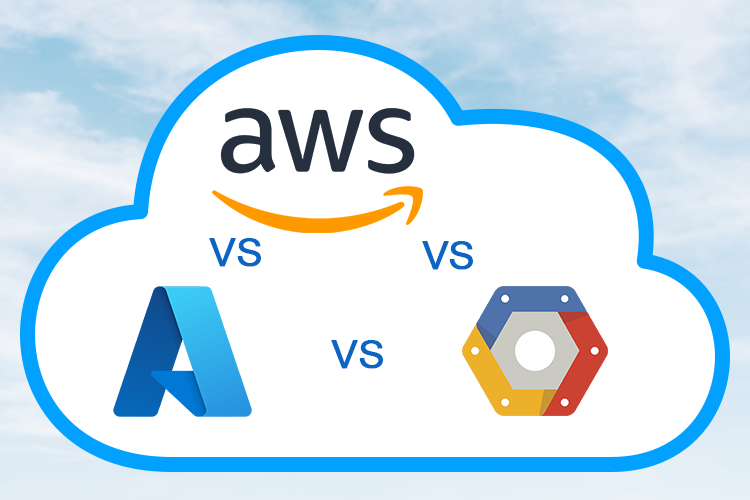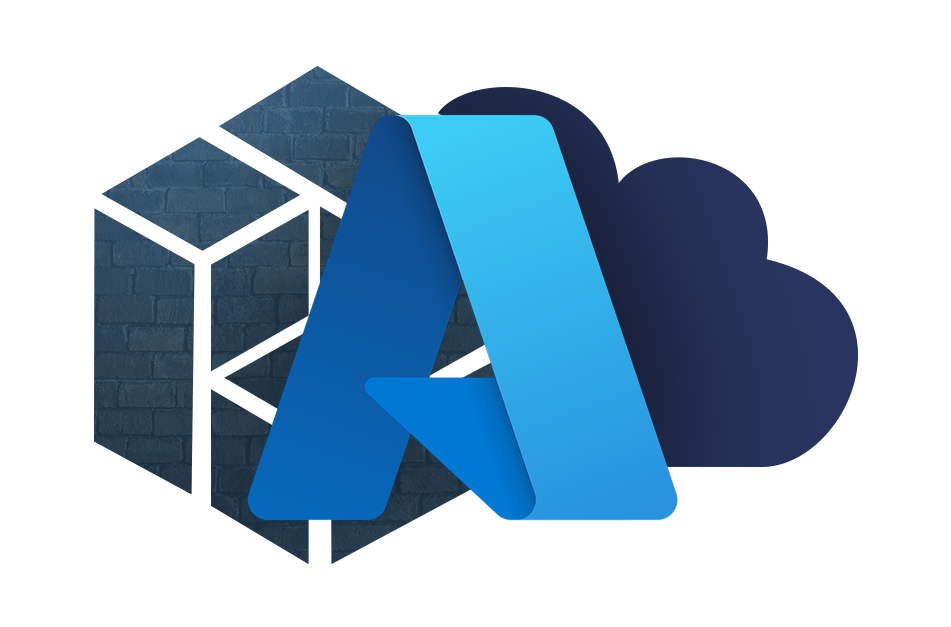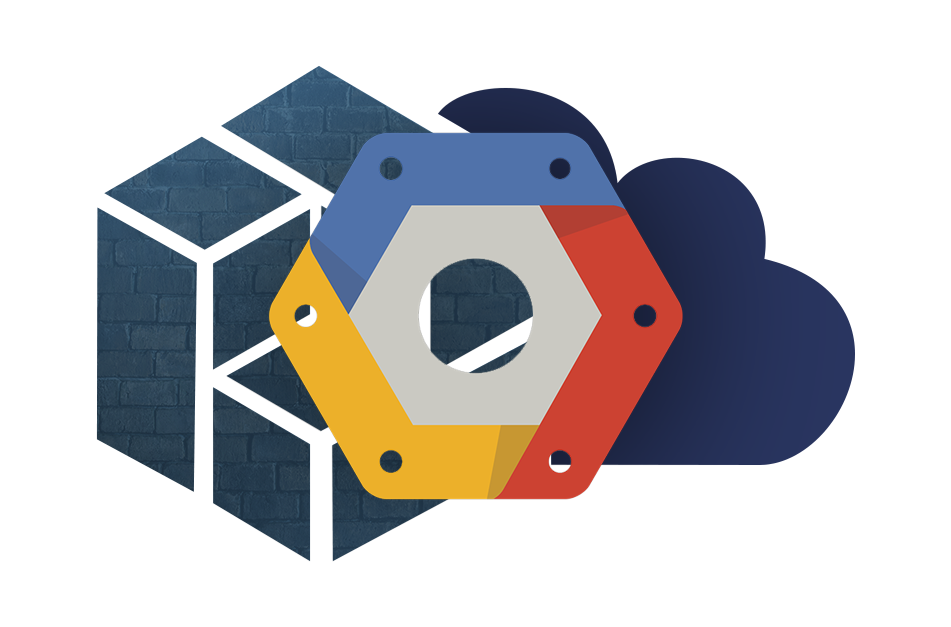Aws vs Azure vs Google Cloud
Top Cloud Provider in 2023

Aws vs Azure vs Google Cloud
What is a cloud platform?
Cloud computing started gaining traction among companies ever since it was first introduced in the mid-2000s. It is an important business tool that opens the door for many business opportunities via data analysis and storage. Since choosing a cloud provider is one of the most critical business and technical decisions you can make, we would like to compare and contrast the big names that are out there: AWS vs Azure vs Google Cloud.
What is a cloud platform exactly? A cloud platform refers to a server's operating system and hardware in an Internet-based data center. This way, it's possible for software and hardware products to coexist remotely.
The cloud platform is a set of services, tools, data storage space, servers, software, and other things for casual users and big companies in an online-based data center.
How do cloud platforms work? Businesses rent access to computing services (servers, software, databases, storage, networking, etc.) Hence, companies don't have to set up and own any data centers or computing infrastructure. They simply pay for the services they use.
There are a few types of cloud platforms. Several models, classes, and services are available to help meet users' exact needs. They include:

Public Cloud
These platforms are third-party providers delivering computing resources over the Internet. Examples are Amazon Web Services (AWS), Google Cloud Platform, Alibaba, Microsoft Azure, and IBM Bluemix.

Private Cloud
A private cloud platform is exclusive to a single enterprise. It's usually in an on-site data center or is hosted by a third-party service provider.

Hybrid Cloud
This is a mixture of public and private cloud platforms. Data and applications move harmoniously between the two. A hybrid cloud solution allows the enterprise greater flexibility while optimizing infrastructure and security.
A cloud platform lets enterprises create cloud-native applications, test and build applications, and store, back up, and recover data. It also allows enterprises to analyze data. Enterprises incorporate intelligence into their operations and deliver software on a global scale.
AWS vs Azure vs Google Cloud providers comparison
Before comparing the current cloud market leaders, let's take a quick look at each cloud service provider:

Amazon Web Services
was launched in 2006 and provided services such as IaaS, PaaS, SaaS, and others. It also possesses an extended coverage zone of 14 regions around the globe.

Azure
is a Microsoft product founded in 2010. Nowadays, the platform offers a wide variety of different supporting instruments and frameworks. It runs on Microsoft Windows and Linux. About 60 services and data centers in more than 38 locations worldwide are currently available on the platform.

Google Cloud Platform
is the youngest among these three — it was launched back in 2011. It offers numerous services, including IaaS, PaaS, and Serverless, while also supporting Big data and IoT. The provider has more than 50 resources and six global data centers at its disposal.
Key strengths
Choosing one cloud vendor among the big three always comes down to each customer's specific needs and workloads. It is often the case that organizations will use multiple providers for different use cases, sticking to a multi-cloud approach.
However, some distinguishing factors separate each firm's approach, which can help users choose which is right for them.

AWS cloud
Starting with AWS, the fundamental strength of the market leader continues to be the breadth of its services, with more than 170 across compute, storage, database, analytics, networking, developer and management tools, IoT, security and enterprise applications. AWS has also done a great job translating its scale into economic benefits for customers. Yet, many companies don't fully understand the pricing on AWS and its impact on architectural decisions and the costs to support such services.

Microsoft Azure cloud
On the other hand, Microsoft cloud services tend to be a top choice for companies that have been committed to the vendor and know that they can consume a great deal of their enterprise computing needs all in one place – from productivity and enterprise software to malleable cloud computing resources for their developers. Thanks to its combination of Azure, Office 365 and Teams, Microsoft is often seen as the safe global pick, but most clients have more than one cloud vendor.
Dive deeper into the topic, exploring the essentials of Azure Cloud and how it can be used.

Google cloud platform
All three vendors are strong in machine learning as they can use immense internal research and development expertise, but this is one area where Google often stands out due to the search giant's unprecedented scale over the past couple of decades. Google also steals the spotlight for its deep expertise around open-source technologies, especially containers. GCP's engineering muscle and how customers gain access to and engage Google engineers have shifted the odds in its favour. Enterprises that seek good quality AI and machine learning capabilities have been gravitating towards the Google Cloud Platform.
Features and services
In essence, AWS, Microsoft Azure and Google Cloud Platform offer pretty similar capabilities revolving around flexible compute, storage and networking. What they have in common are the common elements of a public cloud: self-service and instant, autoscaling, provisioning as well as security, compliance and identity management features.
All three platforms have launched services and tools targeted at advanced technology areas like the Internet of Things (IoT) and serverless computing (Lambda for AWS, Functions with Azure and Google). Machine learning has also been a rampant area in the cloud computing technological escalation lately.
AWS launched SageMaker in 2017 to encourage the adoption of machine learning. The platform also has a broad set of ready-made machine learning services for use cases like image recognition, text-to-speech learning models, and Alexa's engine.
Microsoft's Azure Machine Learning lets developers write, test and deploy algorithms, along with accessing a marketplace for off-the-shelf APIs.
Google offers a one-stop-shop AI platform, allowing machine learning engineers to build and deploy models based on its popular open-source TensorFlow deep learning library.
The recent craze around containers is considered, with all three providers offering managed services around superior container services like Kubernetes.

Computational Power
For various cloud computing services, AWS offers its Amazon Elastic Compute Cloud (EC2) instances, which can be tailored with many options. It also provides related services such as Amazon Elastic Container Service (Amazon ECS) for Amazon Elastic Kubernetes Service (EKS), Elastic Beanstalk for app deployment, the EC2 Container Service, AWS Lambda and Autoscaling. Amazon Virtual Private Cloud (Amazon VPC) enables you to launch AWS resources into a virtual network that you've defined.
Moving to Azure's compute offering, it's centred around its Virtual Machines (VMs inside an Azure virtual network.), with other tools such as Cloud Services and Resource Manager to help deploy applications on the cloud, and its Azure Autoscaling service.
Google's scalable Compute Engine delivers VMs in Google's data centers. They are quick to boot, come with persistent disk storage, promise consistent performance and are highly customizable based on the customer's needs.
If you are looking to implement Function as a Service (FaaS) which is a serverless cloud computing service with serverless architecture, you will need to consider the languages that each platform supports. Google Functions support Node.js and Python 3.7. Azure Functions support C#, Python, Java, Node.js, PHP.
Databases
All the major service providers offer multiple tools and service options pertaining to databases.
All three providers support relational databases – that's Azure SQL Database, Amazon Relational Database Service, Redshift and Google Cloud SQL, as well as NoSQL databases with Azure DocumentDB, Amazon DynamoDB and Google Bigtable.
Cloud Storage
Let's go through the technologies used by our pioneers to keep data on their platforms intact and protected.
AWS uses Simple Storage Service for storing and Amazon Glacier service for archiving your data. Meanwhile, Azure and Google Cloud Platforms own high-performance capabilities with solid security storage.
Concludingly, Azure company is actively implementing and improving file backup and recovery features. Using a sub-service StorSimple as a hybrid storage service for corporate clients has dramatically improved the company's efficiency. It allowed saving up to 60% of the usual value.
Storing all of your data on the cloud servers is one thing, but accessing is a whole new ball game. This is why in addition to the storage size, you need to know how quickly you might need access to this data in the future and if the vendor can provide such speeds for you. While only you can answer the first part of the question, there is a way for you to see how quickly you can access the data. Vendors offer input/output operations per second rate (IOPS). Google offers a higher IOPS than any other provider with 40,000 IOPS for reads and 30,000 for writes. Azure has only 5,000 IOPS. Google also offers its customers a wider selection of the size of the block storage volume. This will range between 1 GB and 64 TB for Google compared with 1 GB and 1 TB for Azure.

Security
Microsoft and Google are known for their high level of security in cloud information storage. Both providers have established a model based on years of development history.
There are three ways to achieve security of such level:
-
Security of the cloud platform itself is gained through a built-in cloud platform infrastructure that enables default protection.
-
Security in the cloud platform with access to security services that can be configured to protect personal data and applications.
-
Security anywhere, with extended security capabilities beyond the cloud platform to protect user assets no matter what their location is.
Along with that, Google and Azure carry out their security policy in a way that meets the requirements of CSA STAR, GDPR, HIPPA, PCI-DSS, and the standards of ISO.
Azure's security level today is the highest among the three cloud platforms listed here. It acts in accordance with more than 90 quality benchmarks in 50 world areas. For instance, Google's compliance matches only 45 of them.
Hybrid options
A focus on helping to serve customers' hybrid and multi-cloud needs has been gaining recognition amongst the public cloud providers in the past years.
This usually applies to customers who deploy across multiple platforms' infrastructure yet need to maintain some applications on-premise. Vendors have offered a range of solutions to help serve these customers' needs.
Microsoft has been the go-to option for hybrid deployments amongst the big three for quite some time. The interoperability of its Azure Stack provides customers with the hardware and software required to deploy Azure public cloud services from a local data center with a shared management portal, code and APIs.
AWS announced its first push into hybrid deployments in 2018 with the launch of Outposts. In this fully managed service, the provider delivers pre-configured racks to your premises to run AWS services just as if they were in their data center.
Google then moved in the same direction in 2019 with the release of Anthos, successfully rebranding the Google Cloud Services platform and bringing together a blend of the existing Google Kubernetes Engine (GKE), GKE On-Prem and the Anthos Config Management console. This guarantees unified administration and security across hybrid Kubernetes deployments.

Pricing
Pricing can have a considerable appeal to those who consider switching to the cloud, and with good reason: there has been a continued downward tendency on prices for some time now as the big providers compete. Pricing of the cloud platform depends on many factors, such as customer requirements, usage and the services used.
All three platforms offer reasonable pricing plans with additional cost management options – reserved instances, budgets, and resource optimization accessible to all users.
The IT community has concluded that Microsoft Azure has the lowest on-demand pricing while Amazon tends to stand at the midpoint. However, there is a clear benefit when enterprises already using Microsoft services (Windows, active directory, MS SQL, etc.) move to Azure as it is considerably cheaper than other cloud providers.
As we said earlier, the price will depend on your individual needs, such as bandwidth, storage, types of instances, and many other factors. When you visit the website of each individual provider, they will have a pricing calculator that you can use to get an approximate cost of services you need.
Pros and cons
As we mentioned earlier, the reasons for picking one platform over another will vary for each customer. Yet the clouds all have aspects that will benefit in certain circumstances.
AWS pros and cons
AWS had a headstart on the contest, expanding its cloud services since 2006. All of them are built to be enterprise-friendly, making them appealing to CIOs and their core audience of developers.
The vendor's platform configuration options, policy features, security and reliability are ranked pretty high. Its partner ecosystem and general product strategy are also considered market-leading, and its AWS Marketplace has numerous third-party software services.
Build stronger relationships with your clients utilizing custom AWS solutions.
However, one area AWS fails to live up to is the hybrid cloud strategy, with its tendency to dismiss the benefits of on-premise private clouds. As stated above, the vendor is slowly complying with the idea, though. Another weak spot of AWS is the scale of its offering. Having these options to pick from is attractive yet challenging to navigate the large number of features offered, and some see AWS as a way too complex vendor to manage.

Microsoft Azure pros and cons
The considerable leverage for Azure is about Microsoft already having a strong root within an organization and can easily participate in helping those companies transition to the cloud. Essentially, Azure links well with key Microsoft on-premise systems such as Windows Server, System Center and Active Directory.
Companies that are strategically committed to Microsoft commonly choose Azure as their primary IaaS+PaaS provider. Microsoft utilizes its massive sales reach and ability to co-sell Azure with other Microsoft products and services to drive further adoption.
Microsoft has also become increasingly receptive to open source technologies, with around half of its workloads now running on Linux.
Build stronger relationships with your clients utilizing custom Microsoft Azure solutions.
However, one of the disadvantages has been a history of outages over the years, including a major global outage in May 2019. We recommend considering disaster recovery capabilities away from Azure for critical applications hosted in the cloud.

Google Cloud Platform pros and cons
Google has a good track record with innovative cloud-native companies and stands tall in the open-source community, but has naturally struggled to conquer the enterprise market.
Google Cloud generally appeals to specific customers thanks to its strengths in big data and other analytics applications, machine learning projects and cloud-native applications. Its go-to-market strategy has been shifted towards succeeding in smaller, innovative projects at large organizations instead of becoming a strategic cloud partner.
Google showcases an instability of processes and procedures when dealing with enterprise accounts, making the company difficult to transact with sometimes. This can be associated with its up-and-coming focus on the enterprise market. This slight disadvantage is most noticeable in contract negotiation, discounting and integration with enterprise systems and support.

Verdict
Although AWS is the current frontrunner regarding service and capacity, Microsoft and Google are growing stronger in this three-way battle. Microsoft, in particular, is close behind AWS with its attention to the enterprise. In the meantime, Google constantly increases its presence by providing integrations with open-source projects and third-party services.
All things considered, it's not about choosing the best cloud providers but rather about choosing the best-suited cloud provider for your needs as a potential customer. As the market grows, most enterprises are opting for multi-cloud strategies to increase the strengths offered by each cloud provider without sticking to a single provider.
This comparison between AWS vs Azure vs Google Cloud was meant to be used as a general guide for getting an overview of each service. If you would like to get more detailed information, it would be good to hire an external provider specializing in cloud computing and provide you with more detailed information on which one is right for you.


